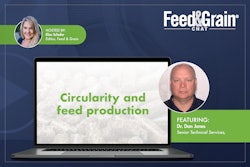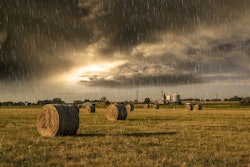Elise Schafer, editor of Feed & Grain:Hi, everyone, and welcome toFeed & Grain Chat. I'm your host Elise Schafer, editor ofFeed & Grain. This edition of Feed & Grain Chat is brought to you byWATT Global MediaandFeedandgrain.com. Feedandgrain.com is your source for the latest news,product and equipmentinformation for the grain handling and feed manufacturing industries.
Today I'm joined on Zoom by Jonathan Martin, director of economics and market analytics forClean Fuels Alliance America. He's here to offer his outlook on the biofuels market and how the next farm bill might influence the future for clean fuels.
Hi, Jonathan. Thanks for joining me today.
Jonathan Martin, director of economics and market analytics,Clean Fuels Alliance America:Hello. I'm very happy to be here. How are you?
Schafer: Doing well! Now let's get right into it. What are the biggest factors contributing to the projected growth of us biodiesel and biofuel demand in the coming years?
Martin:There's a lot of things going on in our space, in the biomass-based diesel space. One thing that's really driving everything is a huge demand for cleaner fuels for transportation, right. And so, you're seeing a lot of people wanting to switch, and what product is readily available in the heavy duty space and the heavy duty transport space is biodiesel and renewable diesel, right? They're already here, they're already available. And they can reduce greenhouse gas emissions considerably.
And so there's a large push from a corporate standpoint and from a government standpoint to reduce greenhouse gas emissions. And that's one of the big drivers from the state side. I'm sure we'll talk about the Renewable Fuel Standard here in a little bit, but from the state side, California has its LCFS program. So low carbon fuel standard, it's LCFS has been pretty much far exceeding its original goals.
As you can see for California, their diesel pool for the first quarter this year — so first quarter 2023 — the numbers show that the diesel pool has actually been 57% clean fuels. So, biomass-based diesel actually made up more than half of the entire diesel pool in the entire state of California. So that's driving a lot of demand, especially for renewable diesel.
然后在West Coast, there's other LCFS programs in Oregon and Washington. And so Oregon, I believe, is that about 14% of their diesel pool is biomass-based diesel, Washington's relatively new, so we're still waiting on that data to come in. But also there are state mandates, so an example — Iowa has about 11% of their diesel pool biomass-based diesel. So that's significant growth from the state side.
And then also on the oilseed side, you're seeing a lot more processing here in the United States for a lot more soy crush, for example, so this increases the supply of oil. But as we all know, 80% of the bean is meal, right, only 20% about is oil, so that also is leading to a lot more meal and lowering the cost of meal for feed.
Schafer: Absolutely! Now, let's focus more on the EPA 's latest Renewable Fuels Standard. Which aspects help support biofuels expansions, and which aspects did the alliance and soybean groups, for example, disagree with?
Martin:First a primer on the Renewable Fuels Standard, right. So they're basically set, blending amounts sets the total demand in the United States essentially for — sorry, using economics here — so set consumption levels of, of biomass-based diesel in the entire diesel pool. That's one thing it does also sets it for ethanol, as well and other biofuels. So they have been slowly increasing the amount over time, however, with all this huge growth and production that we're seeing in the biomass-based diesel space, clean fuels, we kind of took a little bit of an issue with their final rule, which we were basically pushing to get a lot more biomass-based diesel in theD4 RIN (Renewable Identification Number)space.
So, D4 RINS cover biomass-based diesel, and so we were hoping that they would basically give us quite a bit more than what actually we're seeing. We've actually seen since beginning of the year, we've already exceeded this year's total, I believe. The EPA had set a demand target of around 2.8 billion gallons of biomass-based diesel and as of last month, so as of August, we've already blended 3.14 billion gallons of biomass based-diesel in the pool. So, we're already exceeding that level. Also, within the RINS, there’s a lot of econ discussion there, but essentially, that you can blend higher numbers than that, as well. And if we continue on the pace that we are currently blending biomass and biomass-based diesel, we'll actually exceed that the entire blending pool, basically rule that the EPA has set.
所以,这是非常令人鼓舞的,显然,成长th in the industry has been so fast and so quick, but also, it's kind of a little bit frustrating that the written situation is what it is. When prices have dropped as a result, of course, which could be both a good and a bad thing, we're also seeing more exports as well, because of not being able to blend as much stability and the tax policies enable the industry also to expand and invest in new feedstocks. And I think we've kind of discovered that and discussed that a little bit. But, as an example, another thing has been talked about a lot is US cooking oil.
And we just as Clean Fuels Alliance America just commissioned a study and it was just posted, I believe, last week. And we are projecting that there is about an untapped potential somewhere between 4 and 7 billion gallons of used cooking oil that's not currently being tapped in the entire global landscape. And so, there's a lot of feedstock out there that needs to find a home. And so, we still see encouragement for growth from biomass-based diesel. Obviously, we would like the EPA to account for that a little bit more.
Schafer:Shifting to USDA, how might the nextFarm Billinfluence biofuels production? And what programs is the Alliance hoping to see funded?
Martin:So, the Farm Bill has always been important, right. So you know, a lot of things come from the Farm Bill, a couple of them that are specific to our industry. One of them is theHBIIP program. If you don't know what HBIIP is, it stands for higher blends infrastructure incentive program. In the 2018 Farm Bill, there was about $500 million set aside in order to help invest in the biofuels space. You know, the issue is we can produce a lot of it, but how do we get it to market, right. How do we get this product to where people are buying it at the pump, right. And so, this program helps basically achieve higher blends by allowing infrastructure to be built. We would obviously like that to be continued in the next Farm Bill. We think that's been very helpful.
We have a lot of companies that use that seed money from the USDA to help them with making their own infrastructure improvements. Another program that we would like to see reauthorizes theBioenergy program for advanced biofuels. That's a mouthful, so I apologize, but essentially, it provides some extra incentives for producers that USDA ultimately ends up helping us with. And then you would also have infrastructure as a big key of this and so there are also matching grants that USDA provides. That's also built into the Farm Bill, and so we would obviously like to see that continued as well. And I believe from our talks with USDA and with members on the Hill, it sounds like a lot of these things will likely be in the Farm Bill, but obviously the Farm Bill is rather contentious right now. So, we'll see how that goes. We also have to make sure that the government shutdown too, could delay the farm bill as well.
Schafer:Yes, of course — lots yet to be seen. But thank you so much for your update today, Jonathan!
Martin:Thank you very much. It's great to be here.
Schafer:Well, that's all for today's feeding green chat. If you'd like to see more videos like this, subscribe to our YouTube channel, sign up for the industry, watch daily e newsletter, or go to feed and green.com and search for videos. Thank you again for watching, and we hope to see you next time.
That’s all for today'sFeed & Grain Chat. If you'd like to see more videos like this, subscribe to ourYouTubechannel.Sign upfor the Industry Watch daily eNewsletter or go tofeedandgrain.comand search forvideos.






















